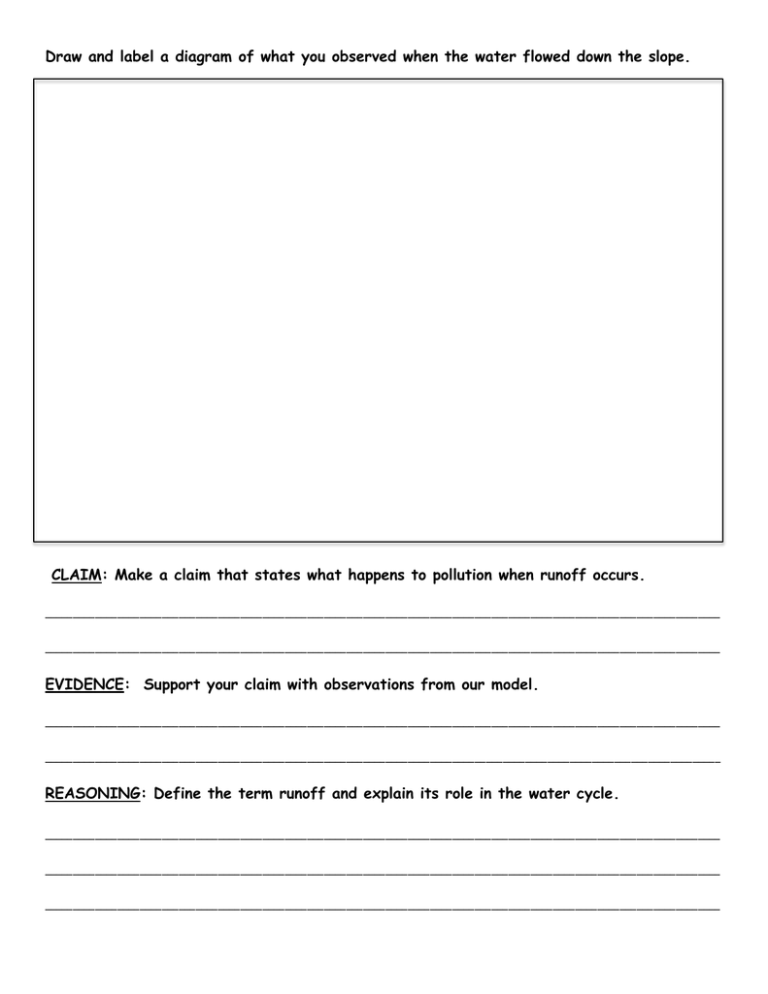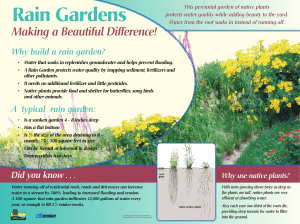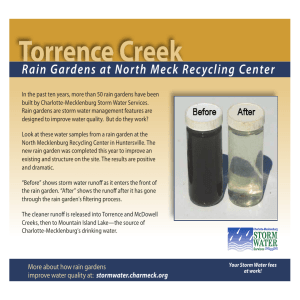Draw and label a diagram of what you observed when the water
advertisement

Draw and label a diagram of what you observed when the water flowed down the slope. CLAIM: Make a claim that states what happens to pollution when runoff occurs. _________________________________________________________________________________________________________________________ _________________________________________________________________________________________________________________________ EVIDENCE: Support your claim with observations from our model. _________________________________________________________________________________________________________________________ _________________________________________________________________________________________________________________________ REASONING: Define the term runoff and explain its role in the water cycle. _________________________________________________________________________________________________________________________ _________________________________________________________________________________________________________________________ _________________________________________________________________________________________________________________________ Draw and label a diagram, using the following terms to label the parts of the aquarium model: rainwater, ground surface, soil, plants, storm drain, bedrock, groundwater, pollution CLAIM: Write a sentence that states how plants affect the impact of runoff. _____________________________________________________________________________________________________________________ ______________________________________________________________________________________________________________________ _______________________________________________________________________________________________________________________ EVIDENCE: Use evidence from our investigation to explain how plants affect the amount of pollution that enters a storm drain. ______________________________________________________________________________________________________________________ ______________________________________________________________________________________________________________________ _______________________________________________________________________________________________________________________ REASONING: Explain the role of plants in the movement of water in the water cycle. ______________________________________________________________________________________________________________________ ______________________________________________________________________________________________________________________ _______________________________________________________________________________________________________________________ Determine the relative amount of sun near the storm drain Area around the storm drain is (circle): Sunny Mostly Sunny Some Shade Completely Shady Calculate drainage area To determine the size of the area that will drain into the rain garden, we will measure the size of the baseball field adjacent to the storm drain. Drainage area = ____________ m X __________ m = _______________ m2 length width Measure slope to determine depth of the rain garden Measure the total length of the string and the height of the string at the downhill stake in centimeters. Divide the height by the length of the string and multiply the result by 100; this is % slope. _______________ / ______________ X 100 = _____________ % height length slope Once you have the % slope, use the following chart to identify the appropriate soil depth for the rain garden. Circle the appropriate depth on the table. Slope Depth <4% 7.5-14 cm 5-7% 15-18 cm Determine the soil type near the storm drain 1. Grab a handful of moist soil and roll it into a ball in your 8-12% 20+ cm hand. 2. Place the ball of soil between your thumb and the side of your forefinger and gently push the soil forward with your thumb to form a ribbon about 1/4” thick. 3. Extend the ribbon until it breaks on its own. Use these guidelines: Sand: soil does not form a ribbon at all Silt: soil forms a ribbon <1.5” before breaking Clay: soil forms a ribbon >1.5” long Soil near the storm drain is mostly (circle one): SAND SILT CLAY Calculate the size factor for the rain garden 1. On the left side of the table, find the soil type near the storm drain. 2. Next, at the top of the table, locate the depth you calculated for the rain garden. 3. Find where the soil type and depth intersect in the table. Circle the number. This is the size factor for the rain garden. No write that number in the blank below the table. The size of the rain garden will be _____________ X _________________ = size factor drainage area (from above) Soil Type Depth 7.5-14 cm 15-18 cm 20+ cm SAND 0.19 0.15 0.08 SILT 0.34 0.25 0.16 CLAY 0.43 0.32 0.20 ______________ m2 size of rain garden Copy the following information from your site analysis data sheet. Type of soil: ____________________________ Amount of sunlight: _______________________ Size of the rain garden: ___________________ Depth of the rain garden: ___________________ Step 1: Do some research. With your partner, use the Internet to find native perennial plants that can live in the type of soil and amount of sunlight near the storm drain. Perennial plants are those that bloom for many years. Make a list of at least eight plants you could use in your rain garden design. Write the common names and a brief description of each plant below. Common Name Description: how tall, flower color, blooming time Step 2: Design your rain garden. Using the graph paper provided by your teacher, draw a sketch of your rain garden. Include the following elements in your design: An outline of the shape of the garden with size dimensions. Use size of the rain garden to determine how big the rain garden should be. Indicate what kinds and how many of each plant will be included in the rain garden Decide the plants will be placed and draw symbols for each plant to show where they will be placed in the garden. Include a symbol key to represent the different types of plants – make sure you show which symbol belongs to which plant Step 3: Describe your rain garden design. Write an 8-10 sentence paragraph to explain your design. Include the following in your response: 1) How big and what shape did you make your rain garden? Why did you choose this? 2) List the plants you used in your design. Explain why you placed them in the design the way you did. 3) Why was the storm drain chosen as the location for the rain garden? 4) How does storm water that enters the drain now affect the Chesapeake Bay? How might the rain garden help reduce storm water runoff and improve the Bay? Design Description Presentation Total number of statements that apply to our design Total number of statements that apply to my written response Total number of statements that apply to our presentation Teacher Comments Total Total number of statements that apply to our design One thing you did well is ______________________________. 1. We chose 8 or more native plants. 2. We used different shapes on our design to represent different types of plants. 3. We included a symbol key that gives the name of each plant next to its shape. 4. Our plants are appropriate for the type of soil and amount of sunlight near the storm drain. 1. We clearly outlined the shape of our garden on our design. 2. We marked the dimensions of our garden on our design to show how big it will be. 3. We chose the shape of our garden so it will capture the most storm water. 4. We arranged plants in our design so the garden is attractive. In my written statement, I… 1. stated how big and what shape our garden would be and explained why it’s this shape, 2. described why we arranged our plants as we did 3. explained why the storm drain was chosen as the place for our rain garden 4. explained how the rain garden will improve the health of the Chesapeake Bay During our presentation, my group and I… 1. explained why we chose the rain garden’s size and shape for our design. 2. described how the plants will be arranged in the rain garden. 3. listed the plants we will use in our design. 4. gave reasons why our design should be chosen One thing you could improve upon is ______________________. Plants Circle the statements that apply to you. Write the total number of statements in each box on the right. Add the numbers and write the total at the bottom. Excellent = 14-16 Satisfactory = 11-13 Needs improvement = 810 Poor = less than 8




